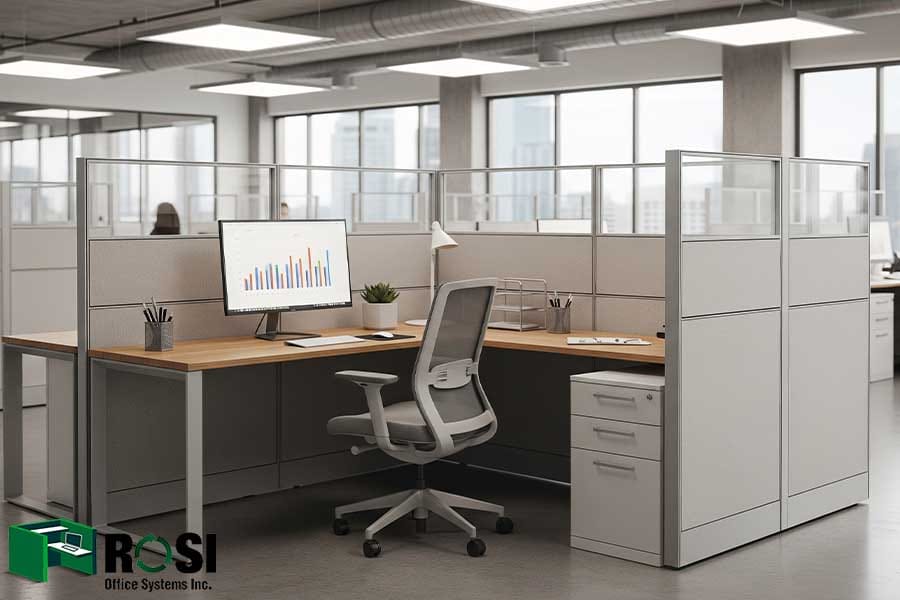
You may be planning to redesign your business workspace or looking to purchase office cubicles Houston for a new office and have come across a wide variety of products and designs.
You definitely don’t know exactly what products you should be looking for, and you’re wondering: What features should an office cubicle have?
In 2025, Key features to look for in office cubicles include durable materials, modular design, sound insulation, privacy panels, ergonomic layout, built-in storage, cable management, easy reconfiguration, quality finishes, and a modern aesthetic that fits your workspace.
In this article, we’ll tell you exactly which features have the greatest impact on employee productivity, comfort, focus, and satisfaction.
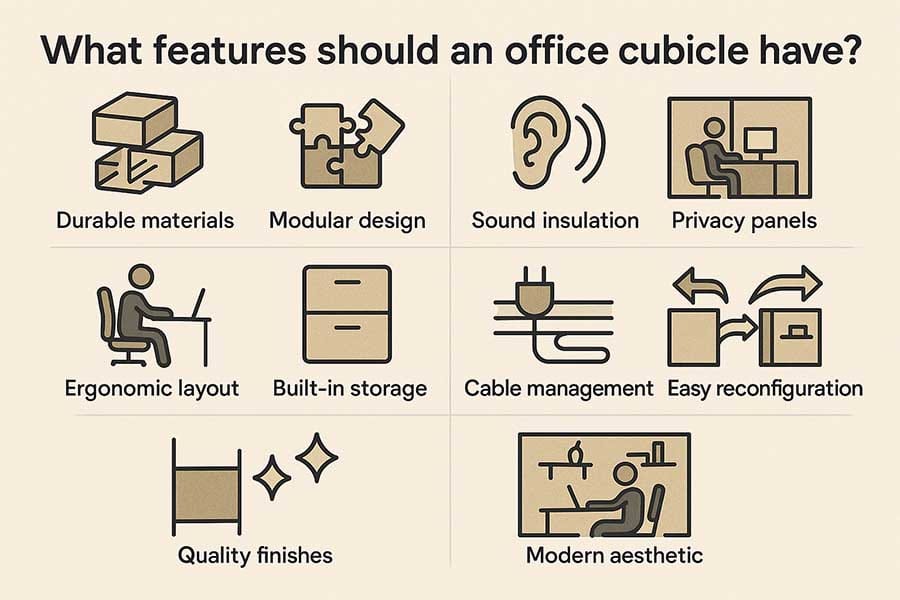
Top 10 Key Features to Look for in Office Cubicles
1. Acoustics & Privacy
One of the main challenges of today’s workspaces, especially in open offices, is the constant presence of noise.
Phone and colleagues’ conversations, typing sounds, printers, and people moving around can seriously disrupt employees’ concentration.
Properly designed office cubicles can largely solve this problem.
These cubicles are made using sound-absorbing materials such as acoustic foam, special fabrics, and fiber panels to absorb environmental sounds and prevent them from being transmitted to the adjacent space.
Sound-absorbing panels are often made of special foam or multilayer fabrics and are installed inside or on cubicle walls to absorb ambient sounds and prevent them from reflecting.
Height extensions also help to completely isolate the workspace by installing additional panels on existing partitions and prevent sound from entering and exiting.
By reducing auditory distractions, employees can be provided with higher concentration, fewer errors, and faster decision-making.
Quieter offices also increase the quality of customer communications, especially in customer service or telesales teams.
2. Ergonomics and Adjustable Design
Ergonomics in office cubicles refers to features that support proper body posture while working and ensure user comfort over long hours.
Since an office cubicle is a space where a person spends many hours of the day, it should be designed to support the body, reduce pressure on muscles and joints, and minimize fatigue.
Height-adjustable desks allow employees to switch between sitting and standing throughout the day.
This change in posture creates less fatigue and prevents problems such as back pain, neck pain, and chronic fatigue.
In addition to these desks, choosing office chairs that have a standard ergonomic design supports the natural curvature of the spine and reduces long-term strain on the back and neck.
Adjustable monitor arms also allow the angle and height of the monitor to be adapted to each person’s height and body posture.
An ergonomic office cubicle should have enough space for a person to comfortably use multiple monitors, paper documents, and personal items without the desk becoming cluttered or boring.
Non-ergonomic design causes long-term physical problems such as herniated discs, neck pain, and carpal tunnel syndrome.
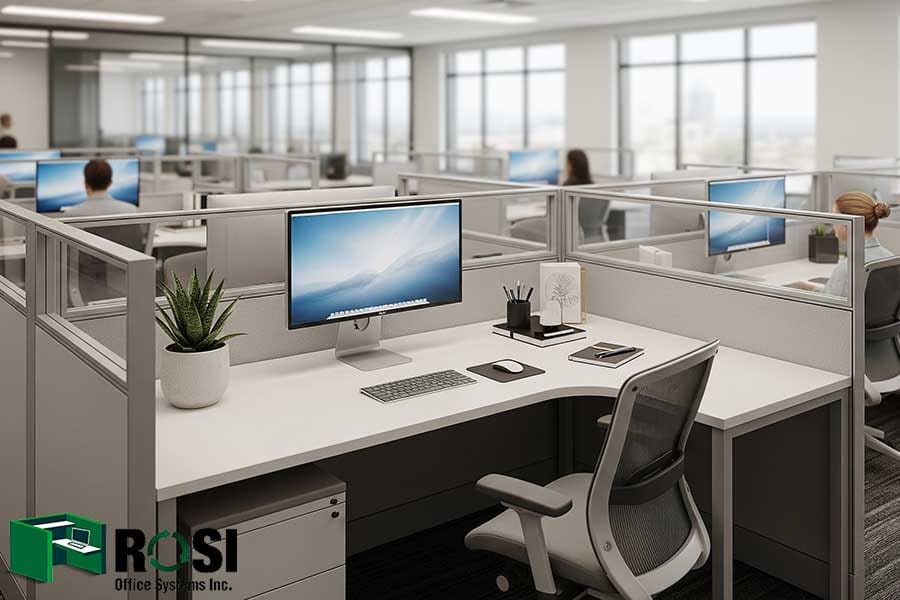
You Might Also Enjoy: What Are Office Cubicles Made of in 2025?
3. Technology Integration and Cable Management
One of the major challenges in offices, and especially in office cubicles, is controlling and organizing the numerous wires and cables that run through electronic devices such as computers, phones, chargers, and other equipment.
Cable management solutions are designed features that neatly and internally organize and keep wires and cables out of sight.
This keeps cables out of the way, off the floor, and makes the workspace look cleaner, safer, and more beautiful.
Also, in modern offices, the need for constant connection to electricity and the internet for a variety of electronic devices, including laptops, phones, monitors, and other work tools, is vital.
Advanced office cubicles provide easy and quick access to power and data transfer with features such as power outlets and USB/Data Ports built into their structure.
With easy access to power and data, employees spend less time searching for outlets or cables and more time focusing on their work.
Plus, neat and hidden cables make your workspace look cleaner and more organized.
4. Customization and Configurability
One of the important features of modern office cubicles is their ability to adapt to different organizational needs.
In an office, roles and layouts may change over time.
For example, one team may need a more open space for collaboration, while another team may need a quieter, more private space.
On the other hand, workplaces are changing rapidly, from employee growth to team structure changes or even company location changes.
Office cubicles that have a modular design allow for easy changes and upgrades without having to replace the entire structure.
This means you can choose or add the height of the panels, the color and material of the covering, and even accessories like shelves or whiteboards to suit your needs.
If your team is growing or you plan to add more people, the modular layout makes the process much easier.
You can also change the structure of the environment depending on new projects or working methods, without having to repurchase.
5. Ample Storage and Organization
In any workspace, the need for a specific place to store files, office supplies, and personal items is a necessity.
Also, one of the important factors in employee productivity is having a neat, orderly, and clutter-free work environment.
One of the features of modern office cubicles is that they are usually designed with built-in storage capabilities so that users can keep personal belongings, documents, office supplies, and equipment in an organized manner.
This feature helps keep your office desk tidy and prevents you from wasting time finding files or work tools.
Pedestal drawers under the desk are designed to store stationery, personal items, or small tools.
Overhead cabinets provide space above the cubicles for storing less frequently used items, such as old documents.
This physical discipline leads to mental discipline and increases a person’s concentration.
A neat and organized space gives the office a professional appearance, especially when in the presence of clients or guests.
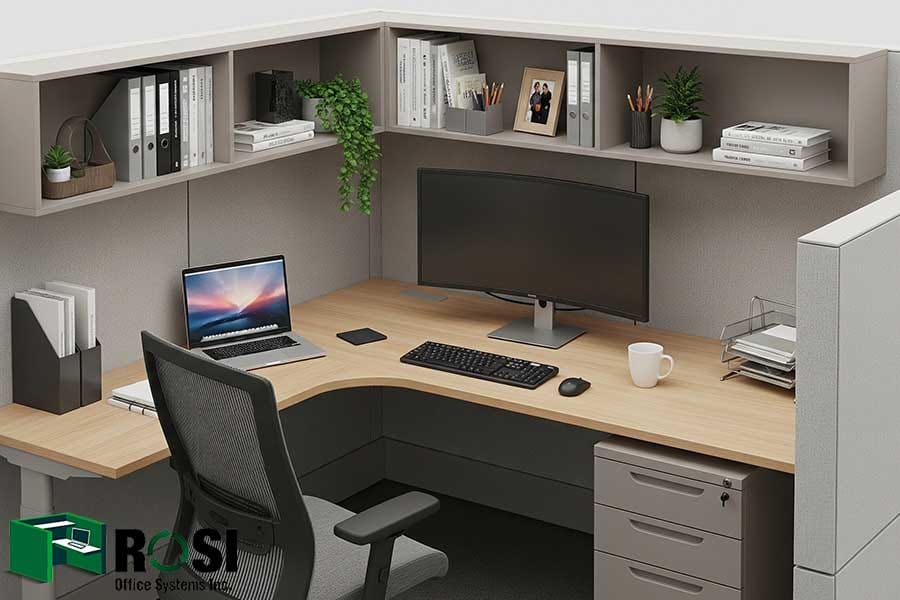
You Might Also Enjoy: What Are the Most Effective Acoustic Panels for Office Cubicles?
6. Quality of Materials and Durability
In busy work environments, office equipment, especially office cubicles, is constantly exposed to daily use.
For this reason, it is absolutely essential to choose cubicles that are made of high-quality, durable materials.
The quality of construction and the type of material used in office cubicles not only affect their durability and long-term performance but also play an important role in their appearance, sense of luxury, and ease of maintenance.
Choosing the right material ensures that office cubicles withstand everyday wear and tear while remaining in harmony with the interior design of the space.
Fabric, the most common option for walls, provides good soundproofing, but can be susceptible to staining.
Glass is modern, transparent, and beautiful.
Suitable for spaces that need natural light and a sense of openness.
Laminate is scratch and stain-resistant, with a wide variety of colors, suitable for high-traffic offices.
Metal Frames Create a strong and stable structure. Usually made of stainless steel.
Higher quality materials, such as industrial laminates or tempered glass, are usually more durable.
On the other hand, some materials, such as glass or laminate, are easier to clean and maintain their appearance better.
Therefore, depending on the style of the workspace (classic, modern, minimalist), you can choose the appropriate material in terms of color, texture, and material.
7. Lighting and Visual Comfort
Proper lighting is one of the key factors in creating a healthy and productive work environment.
Adequate and appropriate lighting not only helps reduce eye fatigue but also has a direct impact on employees’ mood and the quality of their work.
One of the features of modern office cubicles is that they are designed to allow for optimal use of natural light and also have the ability to install or embed task lighting in the appropriate location.
Office cubicles should not block natural light from windows.
Glass designs or translucent panels help light penetrate deep into the office, making the workspace bright and inviting.
Lights that can be mounted on a table or inside a partition provide focused, adjustable light.
These lights allow the user to change the intensity and angle of the light depending on the type of activity, preventing eye fatigue.
A bright environment with sufficient lighting increases motivation and efficiency.
Also, natural light and adjusted lights give a good feeling and positive energy to the space.
8. Privacy and Visual Blocking
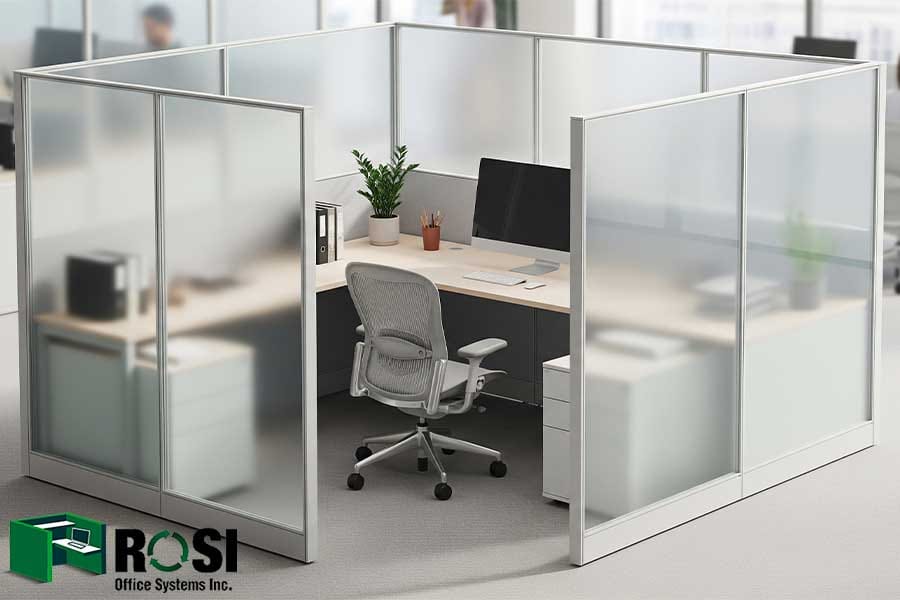
You Might Also Enjoy: What Are the Most Durable Office Cubicles for Small Businesses?
One of the basic needs of employees in open office environments is to have a sense of privacy and personal space.
Proper private office cubicles should block visual distractions as much as possible and provide a calm and focused environment.
This is especially important for tasks that require high concentration.
A well-designed office cubicle with the appropriate height and the use of materials that block direct view helps employees feel more ownership of the space and independence.
The taller the panel, the more privacy it provides.
Frosted glass provides a combination of relative transparency while blocking direct vision.
Privacy screens can also be used as components that can be mounted on a table or the sides of a partition to limit the view around.
This feature of office cubicles prevents distractions when watching colleagues’ movements or passing by.
In addition, having a specific space that is somewhat personalized creates a positive psychological feeling in employees.
In some jobs, maintaining confidential information and preventing others from seeing the monitor or documents is of great importance.
9. Aesthetics, Branding, and Personalization
When designing office cubicles, one should not only think about their practicality, but they should also be visually attractive and consistent with the organizational identity.
Choosing colors, textures, and materials that align with your logo and brand personality helps create a professional and cohesive environment.
In addition, the ability for employees to personalize the workspace, such as placing plants, artwork, or soft and decorative objects, increases belonging and work morale.
Use corporate colors or soft, neutral colors to inspire order and calm, or energetic colors for creative teams.
Design should reflect the brand’s culture and values.
People are happier and more productive in a space where they feel a sense of ownership and comfort.
Brand-aligned design fosters cultural cohesion among teams and creates a sense of pride in the workplace.
A beautiful, professional space also makes a powerful first impression on visitors and prospects.
10. Panel Height and Visual Privacy
One of the important factors in the design of office cubicles is the height of the panels, which directly affects the level of interaction, concentration, and privacy of users.
Depending on the type of work activities, from teamwork to activities requiring high concentration, panels of different heights can be used, or they can be customized with add-ons such as privacy screens or canopies.
By combining different heights, you can create a mixed environment of interaction and focus.
Employees who need to focus use tall panels and dividers to increase productivity.
Instead, sales or marketing teams may need open, interactive spaces, while finance or research teams prefer to work in more secluded spaces.
How to Select the Ideal Office Cubicles for Your Workspace?
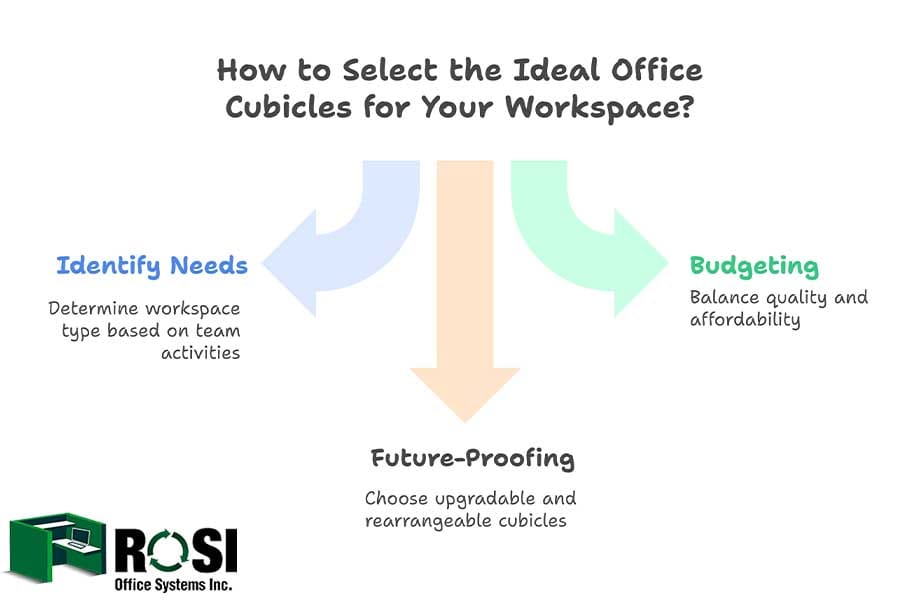
You Might Also Enjoy: Where to Buy Office Cubicles: Top 10 Places in 2025
- Identify Your Needs: Consider the type of work each team does and choose an open or private space accordingly.
- Budgeting: Set a reasonable budget and balance quality and price.
Choose brands that offer high durability and reliable technical support while remaining affordable.
- Future-Proofing: Go for office cubicles that can be upgraded and rearranged in the future.
Conclusion
In this article, titled “10 Key Features to Look for in Office Cubicles,” we discussed the most important points to consider when purchasing and designing cubicles.
Each of these features plays a vital role in increasing productivity, reducing stress, and improving the employee work experience.
Does your team need more focus or modern collaborative office furniture?
What elements are currently hindering employee performance?
Choosing the right office cubicle models, such as Systems 2 Cubicle, is a long-term investment in creating a dynamic, flexible, and purposeful workspace; an environment where employees feel more relaxed, connected, and focused.

John Ofield is a recognized expert in the office furniture and office cubicle industry in Houston, TX, with over 40 years of experience. As the founder of ROSI Office Systems, he specializes in furniture space planning, custom cubicle designs, modern office chairs and tables, and high-quality commercial furniture. John’s expertise helps businesses enhance productivity and collaboration. He is also dedicated to mentoring entrepreneurs and redefining workspaces to inspire success.